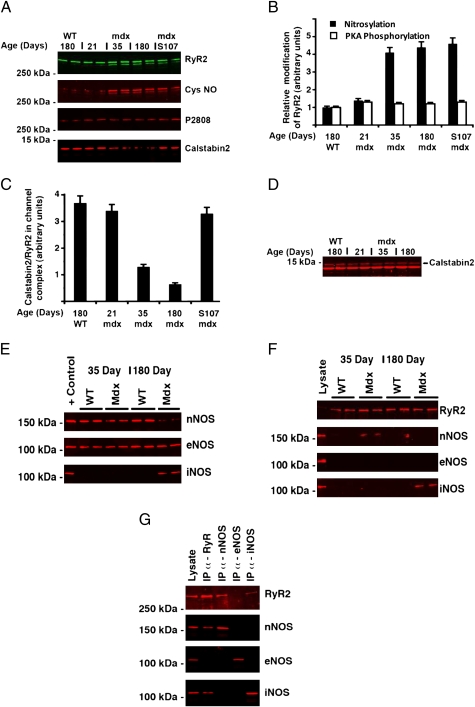Fig. 1.
RyR2 is S-nitrosylated and depleted of calstabin2 in mdx mice hearts. RyR2 was immunoprecipitated from heart homogenate of mdx and WT littermates at 21, 35, and 180 days after birth, as described in SI Materials and Methods. In addition, a group of 5-week-old mdx mice were treated for 2 weeks with S107. (A) Immunoblots prepared for RyR2, S-nitrosylation of cysteine residues on RyR2 (Cys-NO), and calstabin2 bound to RyR2. The blots are representative of three independent experiments. (B) Bar graph depicting the relative amount of RyR2 S-nitrosylation for each group, determined by dividing the Cys-NO signals by the total amount of RyR2 immunoprecipitated. (C) Bar graph depicting the relative amount of calstabin2 associated with the channel complex for each group, determined by dividing the calstabin2 signals by the total amount of RyR2 immunoprecipitated. (D) Immunoblots of heart lysates (100 μg) separated by 15% PAGE, prepared using an anti-calstabin antibody. (E) Immunoblots for nNOS, eNOS, and iNOS in 35- and 180-day-old mdx and WT littermate heart muscle lysate. (F) Coimmunoprecipitation of NOS enzymes with RyR2. RyR2 was immunoprecipitated from 500 μg of WT or mdx heart lysate and probed for RyR2 and the NOS enzymes. (G) Coimmunoprecipitation of RyR2 with NOS enzymes. NOS enzymes were immunoprecipitated separately from 500 μg of mdx heart lysate (35 days for nNOS; 180 days for eNOS and iNOS) and probed for RyR2 and the NOS enzymes. In F and G, positive controls for immunoblotting were 100 μg of 180-day-old WT heart lysate for RyR2, nNOS, and eNOS and 100 μg of 180-day-old mdx heart lysate for iNOS.

